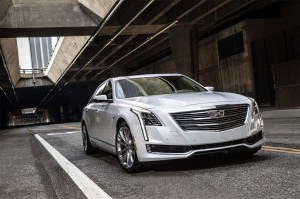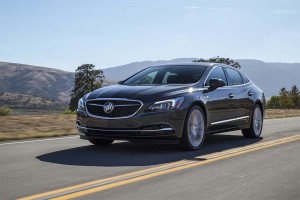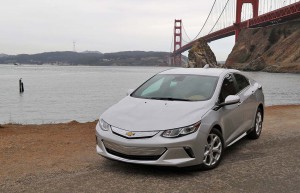
A little more than a year after introducing the Cadillac CT6 as its new flagship model, GM is considering cutting it from the line-up.
At least six General Motors passenger cars could be sent to the scrapyard, according to a report by Reuters, a reflection of the ongoing shift from sedans, coupes and sports cars to SUVs, CUVs and pickups.
But GM isn’t alone. An array of nameplates vanished during the 2017 model-year, with manufacturers expected to pull even more of their slow-selling products from market in 2018. At the same time, expect to see a number of new light trucks fill in those empty spaces.
While GM officials declined to discuss the Reuters report – which included such familiar names as the Chevrolet Impala, Cadillac XTS and even the Chevrolet Volt – officials with the United Auto Workers union met with the carmaker to find out what such a move would mean for thousands of hourly workers.
Automakers have long moved to abandon slow-selling models. And the list of products during 2017 was a long one. GM, for example, already killed off the likes of the Buick Verano and the Cadillac ELR. And Fiat Chrysler Automobiles killed off the only two passenger car models still built in the U.S.: the Dodge Dart and Chrysler 200, while the last Dodge Viper will roll off the assembly line in just a few weeks.
(UAW eyeing production levels at GM’s U.S. plants. Click Here for the story.)
Imports haven’t been immune. BMW wrapped up the Z4’s run. Honda dropped the CR-Z, while Hyundai killed off the Genesis Coupe. And Volkswagen pulled the covers back over the Eos convertible. Toyota dropped the entire Scion brand, which had long focused on passenger cars. Three models, including its first-ever SUV, however, were shifted over to the Toyota brand.

The Buick LaCrosse is one of six cars rumored to be getting the ax as GM focuses on producing more SUVs and crossovers.
There were a few light truck models dropped for 2017, including the Chrysler Town & Country, the Cadillac SRX and the Land Rover LR4. But, in virtually every instance, they were replaced by new models – such as the Chrysler Pacifica – or they were slow-selling green variants, like the Subaru Crosstrek Hybrid.
Pushing into 2018, still more models are going away, including the largely unloved Lexus CT 200H hybrid, the Hyundai Azera and the Honda Accord Coupe. There are actually two utes on the list for ’18, including the Jeep Patriot, which will be replaced by the newly redesigned Jeep Compass, as well as VW’s Touareg – which will effectively be replaced by the more affordable and equally roomy Atlas.
In today’s market, where pickups, SUVs, CUVs and other light trucks account for almost two-thirds of new vehicle sales, it should be no surprise, then, that GM is seriously considering killing off six more passenger cars. The complete list, according to Reuters:
- The Buick LaCrosse; a solid sedan but lost among the SUV models that have helped revive the long-struggling brand;
- The Cadillac CT6; introduced little more than a year ago as the brand’s new flagship;
- The Cadillac XTS, a front-drive model that never really fit and was widely expected to be killed off within a few more years;
- The Chevrolet Volt, a well-reviewed plug-in hybrid that hasn’t charged up the market;
- The Chevrolet Sonic, a small car that has largely vanished in today’s truck-centric market; and
- The Chevrolet Impala, also well-reviewed, but a victim of the shift from sedans to SUVs.
GM officials declined to discuss the Reuters report but other sources confirmed the six models are on the list. And UAW President Dennis Williams all but confirmed the story, saying “We are tracking (and) addressing” the issue.
The UAW clearly has reason to worry. The loss of those products could translate into the closure of several key GM assembly plants, two near its Detroit headquarters. The Sonic, for example, is produced at a facility in suburban Lake Orion that also produces the well-reviewed Chevy Bolt EV. Though not on the list of products whose future is at risk, Bolt sales have been far weaker than expected and the battery-electric vehicle would be hard-pressed to maintain an entire assembly plant on its own.

Even a refresh from the first-gen model likely won't save the Chevy Volt hybrid from the chopping block.
(Click Here for details about how auto sales fell in June in the U.S.)
The other plant at risk is the Detroit-Hamtramck factory, better known as the Poletown plant.
What is far from certain is whether GM would shutter those underused facilities or find alternative products. By next year, both the Dodge Dart and Chrysler 200 factories will be rolling out new light truck models for FCA.
Ford, meanwhile, is shifting its Focus sedan to a Chinese plant and converting its Michigan Assembly Plant, a half-hour west of Detroit, to produce two revived truck nameplates: the Bronco SUV and the Ranger midsize pickup.
GM also is working up an assortment of new light trucks. Cadillac, which could be hard hit by the current product review, is developing as many as three different new utility vehicles, brand boss Johan de Nysschen has told TheDetroitBureau.com.
But the automaker has plenty of problems at other plants where new products might be needed. Since last November, it has dropped shifts at six of its factories, and that’s on top of temporary cuts meant to bring production in line with retail demand.
(New car sales have peaked in the U.S., new study shows. Click Here for the story.)
If the U.S. new vehicle market continues to slip, as many expect it to do over the next few years, GM will likely have to make a number of difficult decisions about production capacity and its model line-up.

The “new” GM didn’t learn anything from “old” GM. None have learned, to be quite honest.